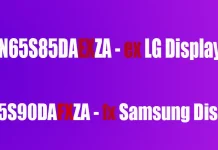LG TruMotion is a feature designed to improve the picture quality of LG TVs. The TV further processes the received video stream to improve the picture, with the side effect being an increase in picture lag time. There is also a TruMotion technical specification created for marketing purposes for ratings (called the motion index) that doesn’t mean anything but adds a tremendous amount of confusion to the understanding of TruMotion.
The purpose of TruMotion in LG TVs
TruMotion was initially designed to solve the problem of jerky images on LED TVs when displaying video at low frame rates. This problem became noticeable when TVs with 60Hz or 120Hz screens became available, while much of the available content was produced at lower frame rates. TruMotion has also evolved to reduce image blurring. With software improvements, this feature has received additional tweaks, allowing for more precise control over how the technology works.
How LG TruMotion works, explanation
If TruMotion is enabled in the settings, the feature is activated when the TV’s refresh rate exceeds the frame rate of the original video. If the video’s frame rate is the same as the TV display’s refresh rate, TruMotion remains inactive even if enabled in the settings.
Let’s break down how TruMotion algorithms work: if the TV detects that the received video has a low frame rate and the feature is enabled, the TV increases the frame rate by repeating the existing frames. Contrary to LG’s advertising claims, the TV does not create new intermediate frames because it is almost impossible to calculate the trajectory of every object on the screen accurately. As a result, the image becomes super smooth, leading to the infamous “soap opera effect.”
Reducing image shake and motion blur
LED TVs cannot instantly erase an image, and even after it disappears, the viewer’s brain continues to perceive it for a brief moment – this is known as a “residual image” on the retina. To speed up the process of removing this residual image from the viewer’s perception, technology has been developed that inserts a black frame between video frames. However, the black frame is not inserted; the TV turns off the backlight briefly, helping the residual image to disappear from the retina more quickly. This process effectively reduces the blurring of moving objects.
LG TruMotion controls and settings
Of course, if you’re watching the video, enabling this setting is better. Modern programs and videos usually support quite a high frame rate, but if the original image has a low frame rate, the TV will improve the picture.
And if you’re using your TV as a display for a game console, it’s not a good idea to introduce a significant delay in the input signal when processing the image.
Before 2022, the TruMotion setting had no additional settings; you could turn it on or off; after 2022, there is more fine-tuning, and now you can control the following settings.
- Off/ON: Turns off the TruMotion.
- Cinematic Movement: Adjusts the shaking of the motion on the screen to make it feel like you are in a movie theater.
- Natural: Sets images with a lot of motions to look natural and clear.
- Smooth Movement: Softens fast-moving pictures.
- User Selection: Sets TruMotion manually.
- De-Judder: Adjusts juddering on the screen.
- De-Blur: Reduces the blurring effects of motion.
- OLED Motion / Motion Pro: You can make your video more transparent by eliminating afterimages.
The advanced settings can be changed only in User Selection mode. The available options may differ Depending on the input signal or the selected picture mode. The configurable items differ depending on the model.
TruMotion index on LG TVs
TruMotion 120 or 240 is just marketing, LG likes to invent and register different trademarks, which then uses in technical specifications. These values do not carry any specific information. And in the early stages they were in huge numbers and in Hertz, which could not be explained by any common sense logic. Now everything is simpler and tied to the display.
- 60Hz display=TruMotion 120
- 120Hz display=TruMotion 240.
- OLED TV=OLED TruMotion
- Premium LED TV=TruMotion Pro
But as more and more experts criticized this incorrect parameter, for example in the UK TruMotion is no longer used as a parameter.







Thx for article! As I understood this feature isn’t very demanded
This is a really bad article. Several of the sentences make no sense, and the fact that the author thinks TV refresh rates can go up to 400 “MHz” (millions of hertz), confusing processor hertz for image hertz, tells me everything I need to know about his level of competence of the subject matter. The fact that people this clueless can make informative articles about a subject they know nothing about is one of the worst aspects of the internet.
You’re right, that was typo with MHz =) Thx for highlighting this, We’ve corrected the mistake.
Na minha lg se colocar o trumotion no natural ou cinema , ficou ótimo as cenas e não gerou imagens com ruídos em redor do objetos ou qualquer coisa que esteja na cena .
It’s a shame how many folks dislike motion smoothing! It’s fascinating to watch the transformation your favorite movies undergo. I hope that science will keep improving this technology to the point that ALL motions are completely smoothed perfectly, and I believe it can be done!